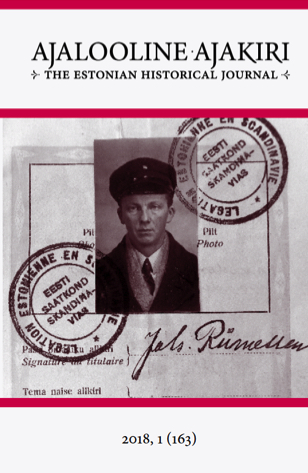Revolutsiooni sidemehed: Eesti enamlikud emigrandid Kopenhaagenis 1918–1921 [Abstract: The couriers of revolution: Estonian Bolshevik émigrés in Copenhagen 1918–1921]
DOI:
https://doi.org/10.12697/AA.2018.1.02Abstract
Abstract: The couriers of revolution: Estonian Bolshevik émigrés in Copenhagen 1918–1921
The history of the early twentieth-century Estonian left-wing radicalism has remained a relatively neglected field in the post-1991 period; not least due to its previous institutional role as the most favoured, but also the most highly politicised subject of historical research in Soviet Estonia. This state of affairs resulted in voluminous scholarship in “party history” produced over the decades following World War II, but its findings and conclusions are almost entirely untrustworthy and thoroughly biased in favour of Soviet-style Communism.
In the last five years, however, the history of the Estonian left has attracted new attention on part of both younger scholars and senior academics – a highly positive development in light of the major role that left-wing ideas and movements have played in Estonian history from the 1905 Russian revolution onwards. Nevertheless, this newer research has the somewhat thankless task of having to re-examine the fundamentals without being able to rely on previous scholarship, which perhaps understandably limits its ability to generalise or to draw overarching conclusions.
The present article is a contribution to this burgeoning field in Estonian historical research, engaging with the little-studied history of Estonian left-wing radicalism in Western Europe (rather than in Estonia or in Soviet Russia). I am particularly focusing on four individuals among émigré Estonians in Copenhagen, Denmark: August Lossmann (1890–?), Oskar Lenk (1890–1919), Johannes Rumessen (1888–?) and Harald Triikman (1892–1964). The primary period of study is 1918–22, although reference will be made to both earlier and later years where appropriate. The study makes use of both Estonian and foreign archival materials, contemporary newspapers and, occasionally, published scholarship.
While my focus is on tracing and contextualising the activities and involvement of these four young men in both Danish and Estonian radical leftist circles, I will also propose some preliminary hypotheses relating to the radicalisation process of left-wing Estonian émigrés more generally, which in the future can hopefully be tested on a broader range of comparable subjects.
Firstly, I would suggest that the Bolshevik Russian revolution (the October Revolution) was likely a pivotal moment in the development of their views: having been the supporters of Socialist Russian revolution, the Estonian émigrés tended to distance themselves from the more sceptical Social Democratic parties of their countries of residence in its aftermath, instead moving closer to Left Socialist or Communist parties that fully embraced the new revolution. Furthermore, their distance from and relative ignorance of Estonian affairs probably left them more open to contemporary Bolshevik propaganda, which among other things depicted the Estonian War of Independence (1918–19) as a struggle between an alliance of foreign capital and the Estonian bourgeoisie on the one hand, and the Estonian proletariat on the other.
In the case of Lossmann, Lenk, Rumessen and Triikman, they were all connected to one Estonian Socialist (or Bolshevik) Group, established in 1918 and affiliated with the Danish Socialist Labour Party – the first openly Bolshevik party in Denmark. This Estonian group was headed by the remarkably well-respected Socialist Oskar Lenk, who in early 1919 was expulsed from Denmark due to his involvement in Bolshevik activities (among other things, working from the Copenhagen bureau of ROSTA, the Soviet Russian news propaganda agency). Later, he was active in Russia as a fairly prominent activist of the Estonian Communist Party, before being killed in a battle against the Whites in the autumn of the same year.
Lenk’s influence in 1918 was likely of formative importance for his comrades in Copenhagen, at least one of whom (Johannes Rumessen) also became involved in the underground transport and intelligence network of the Estonian Communist Party in 1919–20.

